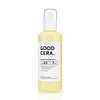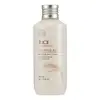What's inside
What's inside
 Key Ingredients
Key Ingredients

 Benefits
Benefits

 Concerns
Concerns

 Ingredients Side-by-side
Ingredients Side-by-side

Water
Skin ConditioningButylene Glycol
HumectantGlycerin
HumectantBetaine
Humectant1,2-Hexanediol
Skin ConditioningDiphenylsiloxy Phenyl Trimethicone
Skin ConditioningTriethylhexanoin
MaskingPolyglyceryl-10 Myristate
Skin ConditioningGlyceryl Polymethacrylate
Aleuritic Acid
Skin ConditioningYeast Extract
Skin ConditioningGlycoproteins
Skin ConditioningSodium Hyaluronate
HumectantPolyquaternium-51
Skin ConditioningHydrogenated Lecithin
EmulsifyingCaprylic/Capric Triglyceride
MaskingCetearyl Alcohol
EmollientCetearyl Glucoside
EmulsifyingGlyceryl Stearate
EmollientStearic Acid
CleansingPhytosteryl/Isostearyl/Cetyl/Stearyl/Behenyl Dimer Dilinoleate
Skin ConditioningCeramide NP
Skin ConditioningHydrogenated Polydecene
EmollientButyrospermum Parkii Butter
Skin ConditioningCeteareth-20
CleansingGlyceryl Citrate/Lactate/Linoleate/Oleate
EmulsifyingHydroxypropyl Bispalmitamide Mea
EmollientGlycosphingolipids
EmollientCeramide AP
Skin ConditioningCeramide EOP
Skin ConditioningMeadowfoam Estolide
Skin ConditioningGlycine Soja Sterols
EmollientEthylhexyl Isononanoate
EmollientPolysorbate 20
EmulsifyingAcrylates/C10-30 Alkyl Acrylate Crosspolymer
Emulsion StabilisingTromethamine
BufferingAlteromonas Ferment Extract
Skin ConditioningBacillus Ferment
Skin ConditioningPanthenol
Skin ConditioningDipropylene Glycol
HumectantLavandula Angustifolia Oil
MaskingCitrus Grandis Peel Oil
MaskingCymbopogon Citratus Leaf Oil
MaskingPelargonium Graveolens Oil
MaskingCitrus Aurantium Dulcis Peel Oil
MaskingPogostemon Cablin Leaf Oil
MaskingSantalum Album Oil
MaskingChamomilla Recutita Flower Oil
MaskingGlycerylamidoethyl Methacrylate/Stearyl Methacrylate Copolymer
HumectantXanthan Gum
EmulsifyingTheobroma Cacao Seed Extract
AntioxidantPropylene Glycol
HumectantNiacinamide
SmoothingAllantoin
Skin ConditioningDisodium EDTA
Ethylhexylglycerin
Skin ConditioningWater, Butylene Glycol, Glycerin, Betaine, 1,2-Hexanediol, Diphenylsiloxy Phenyl Trimethicone, Triethylhexanoin, Polyglyceryl-10 Myristate, Glyceryl Polymethacrylate, Aleuritic Acid, Yeast Extract, Glycoproteins, Sodium Hyaluronate, Polyquaternium-51, Hydrogenated Lecithin, Caprylic/Capric Triglyceride, Cetearyl Alcohol, Cetearyl Glucoside, Glyceryl Stearate, Stearic Acid, Phytosteryl/Isostearyl/Cetyl/Stearyl/Behenyl Dimer Dilinoleate, Ceramide NP, Hydrogenated Polydecene, Butyrospermum Parkii Butter, Ceteareth-20, Glyceryl Citrate/Lactate/Linoleate/Oleate, Hydroxypropyl Bispalmitamide Mea, Glycosphingolipids, Ceramide AP, Ceramide EOP, Meadowfoam Estolide, Glycine Soja Sterols, Ethylhexyl Isononanoate, Polysorbate 20, Acrylates/C10-30 Alkyl Acrylate Crosspolymer, Tromethamine, Alteromonas Ferment Extract, Bacillus Ferment, Panthenol, Dipropylene Glycol, Lavandula Angustifolia Oil, Citrus Grandis Peel Oil, Cymbopogon Citratus Leaf Oil, Pelargonium Graveolens Oil, Citrus Aurantium Dulcis Peel Oil, Pogostemon Cablin Leaf Oil, Santalum Album Oil, Chamomilla Recutita Flower Oil, Glycerylamidoethyl Methacrylate/Stearyl Methacrylate Copolymer, Xanthan Gum, Theobroma Cacao Seed Extract, Propylene Glycol, Niacinamide, Allantoin, Disodium EDTA, Ethylhexylglycerin
Water
Skin ConditioningGlycerin
HumectantAlcohol Denat.
AntimicrobialGlycereth-26
HumectantDipropylene Glycol
HumectantPEG-75
Humectant1,2-Hexanediol
Skin ConditioningOryza Sativa Extract
AbsorbentOryza Sativa Bran Oil
EmollientCeramide NP
Skin ConditioningDimethicone
EmollientPEG-60 Hydrogenated Castor Oil
EmulsifyingHydrogenated Lecithin
EmulsifyingAcrylates/C10-30 Alkyl Acrylate Crosspolymer
Emulsion StabilisingSodium Hyaluronate
HumectantCaprylic/Capric Triglyceride
MaskingPolyglyceryl-10 Oleate
Skin ConditioningLecithin
EmollientGlycosphingolipids
EmollientPotassium Hydroxide
BufferingTrisodium EDTA
Phenoxyethanol
PreservativeEthylhexylglycerin
Skin ConditioningParfum
MaskingHydroxycitronellal
PerfumingLinalool
PerfumingWater, Glycerin, Alcohol Denat., Glycereth-26, Dipropylene Glycol, PEG-75, 1,2-Hexanediol, Oryza Sativa Extract, Oryza Sativa Bran Oil, Ceramide NP, Dimethicone, PEG-60 Hydrogenated Castor Oil, Hydrogenated Lecithin, Acrylates/C10-30 Alkyl Acrylate Crosspolymer, Sodium Hyaluronate, Caprylic/Capric Triglyceride, Polyglyceryl-10 Oleate, Lecithin, Glycosphingolipids, Potassium Hydroxide, Trisodium EDTA, Phenoxyethanol, Ethylhexylglycerin, Parfum, Hydroxycitronellal, Linalool
 Reviews
Reviews

Ingredients Explained
These ingredients are found in both products.
Ingredients higher up in an ingredient list are typically present in a larger amount.
1,2-Hexanediol is a synthetic liquid and another multi-functional powerhouse.
It is a:
- Humectant, drawing moisture into the skin
- Emollient, helping to soften skin
- Solvent, dispersing and stabilizing formulas
- Preservative booster, enhancing the antimicrobial activity of other preservatives
Acrylates/C10-30 Alkyl Acrylate Crosspolymer is a synthetic polymer. It is used to thicken and improve the texture of products. Due to its properties, it can prevent water and oil ingredients from separating.
This ingredient is an emollient, solvent, and texture enhancer. It is considered a skin-softener by helping the skin prevent moisture loss.
It helps thicken a product's formula and makes it easier to spread by dissolving clumping compounds.
Caprylic Triglyceride is made by combining glycerin with coconut oil, forming a clear liquid.
While there is an assumption Caprylic Triglyceride can clog pores due to it being derived from coconut oil, there is no research supporting this.
Learn more about Caprylic/Capric TriglycerideCeramide NP is a type of ceramide.
Ceramides are intercellular lipids naturally found in our skin that bonds dead skin cells together to create a barrier. They are known for their ability to hold water and thus are a great ingredient for dry skin.
Ceramides are an important building block for our skin barrier. A stronger barrier helps the skin look more firm and hydrated. By bolstering the skin ceramides act as a barrier against irritating ingredients. This can help with inflammation as well.
If you would like to eat ceramides, sweet potatoes contain a small amount.
Read more about other common types of ceramides here:
Ceramide AP
Ceramide EOP
Dipropylene Glycol is a synthetically created humectant, stabilizer, and solvent.
This ingredient helps:
Dipropylene glycol is technically an alcohol, but it belongs to the glycol family (often considered part of the ‘good’ alcohols). This means it is hydrating and gentle on skin unlike drying solvent alcohols like denatured alcohol.
As a masking agent, Dipropylene Glycol can be used to cover the smell of other ingredients. However, it does not have a scent.
Studies show Dipropylene Glycol is considered safe to use in skincare.
Learn more about Dipropylene GlycolEthylhexylglycerin (we can't pronounce this either) is commonly used as a preservative and skin softener. It is derived from glyceryl.
You might see Ethylhexylglycerin often paired with other preservatives such as phenoxyethanol. Ethylhexylglycerin has been found to increase the effectiveness of these other preservatives.
Glycerin is already naturally found in your skin. It helps moisturize and protect your skin.
A study from 2016 found glycerin to be more effective as a humectant than AHAs and hyaluronic acid.
As a humectant, it helps the skin stay hydrated by pulling moisture to your skin. The low molecular weight of glycerin allows it to pull moisture into the deeper layers of your skin.
Hydrated skin improves your skin barrier; Your skin barrier helps protect against irritants and bacteria.
Glycerin has also been found to have antimicrobial and antiviral properties. Due to these properties, glycerin is often used in wound and burn treatments.
In cosmetics, glycerin is usually derived from plants such as soybean or palm. However, it can also be sourced from animals, such as tallow or animal fat.
This ingredient is organic, colorless, odorless, and non-toxic.
Glycerin is the name for this ingredient in American English. British English uses Glycerol/Glycerine.
Learn more about GlycerinGlycosphingolipids are naturally found in the cell membranes of organisms. In animals, they are the major glycolipids found.
Glyolipids help ensure the stability of cell membranes. They also help with cellular recognition, such as allowing cells to form tissues in skin.
Hydrogenated Lecithin is created from the hydrogenation of lecithin (a group of phospholipids). Hydrogenation is a chemical reaction between hydrogen and another element.
This ingredient is an emollient and emulsifier. As an emollient, it helps soften skin by trapping moisture within. As an emulsifier, it prevents oil and water ingredients from separating.
Sodium Hyaluronate is hyaluronic acid's salt form. It is commonly derived from the sodium salt of hyaluronic acid.
Like hyaluronic acid, it is great at holding water and acts as a humectant. This makes it a great skin hydrating ingredient.
Sodium Hyaluronate is naturally occurring in our bodies and is mostly found in eye fluid and joints.
These are some other common types of Hyaluronic Acid:
Learn more about Sodium HyaluronateWater. It's the most common cosmetic ingredient of all. You'll usually see it at the top of ingredient lists, meaning that it makes up the largest part of the product.
So why is it so popular? Water most often acts as a solvent - this means that it helps dissolve other ingredients into the formulation.
You'll also recognize water as that liquid we all need to stay alive. If you see this, drink a glass of water. Stay hydrated!
Learn more about Water